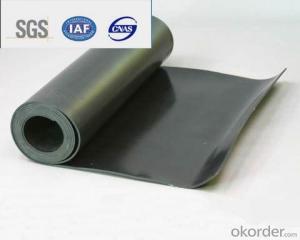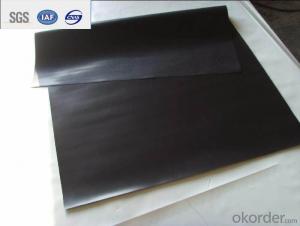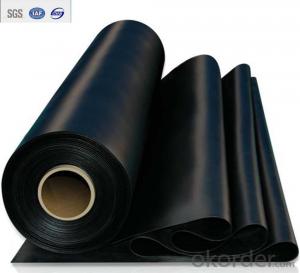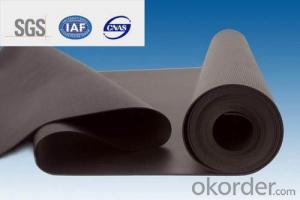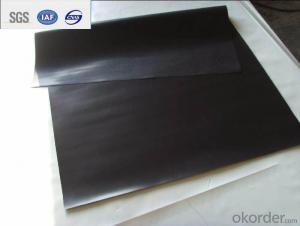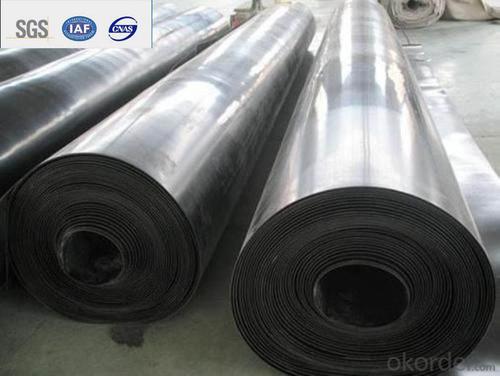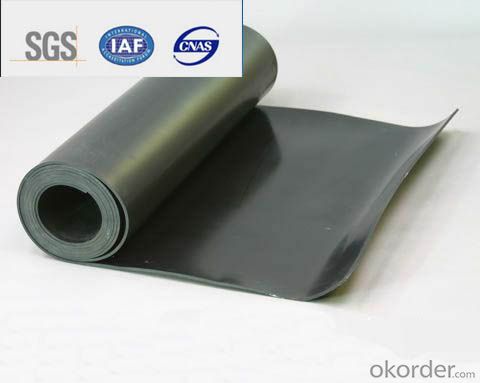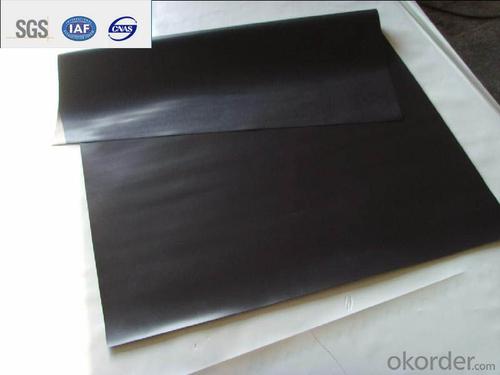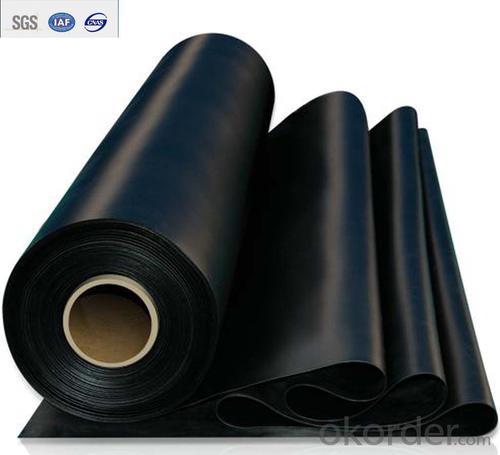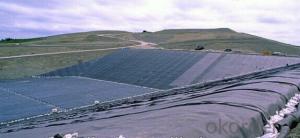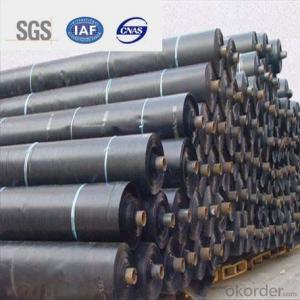EPDM Waterproofing Roofing Membrane with 1.2mm 1.5mm 2.0mm
- Loading Port:
- Qingdao
- Payment Terms:
- TT OR LC
- Min Order Qty:
- 2000 m²
- Supply Capability:
- 800000 m²/month
OKorder Service Pledge
OKorder Financial Service
You Might Also Like
Description Of EPDM Rubber Waterproof Membrane:
Waterproofing layer is imperfect: It’s hard to completely avoid weak points or breakages, which makes waterproofing layer with deficiencies or hidden defects more or less.
The main structure is with defects: It’s hard to completely avoid construction joint, deformation joint and small fissures in structure.
If there are weak points or breakage, water gets in and flude-channeling happens between the main structure and the waterproofing layer. In such cases, once the main structure is with defects, seepages would occur.
Main Features of EPDM Rubber Waterproof Membrane:
1. Excellent physical and mechanical performance
2. High tearing resistance
3. Good deformation adaptability
4. High puncture resistance
5. High aging resistance
6. UV resistance
Specifications of EPDM Rubber Waterproof Membrane:
| EPDM Waterproof Membrane ASTM Standard : D-7465 | ||||
| Property | Test Method | Units | Mininum ASTM | |
| D-7465 | ||||
| Sl | Eng | |||
| Specific Gravity | ASTM D-792 | gm/cc | 1.1 | 1.1 |
| Unit Weight | ASTM D-751 | kg/m2 | 1.3 | 0.27 |
| Thickness Type 1 | ASTM D-412 | mm(in) | 1.02 +15/-10% | 0.04 +15/-10% |
| Tensile Strength. Die C | ASTM D-412 | Mpa(psi) | 9 | 1305 |
| Ultimate Elongation,Die C | ASTM D-412 | % | 300 | 300 |
| Tear Resistance,Die C | ASTM D-624 | Kn/m(lbf/in) | 26.27 | 150 |
| Puncture Resistance | ASTM D-4833 | N(lbs) | 133 | 30 |
| Shore A Durometer | ASTM D-2240 | 65-10 | 65-10 | |
| Ozone Resistance | ASTM D-1149 | No Crack | No Crack | |
| Multiaxial Elongation | ASTM D-5617 | % | 100 | 100 |
| Heat Aging 28 days at 240 degrees | ASTM D-573 | |||
| Tensile Strength, Die C | ASTM D-412 | MPa(psi) | 8.3 | 1205 |
| Ultimate elongation, Die C | ASTM D-412 | % | 200 | 200 |
| Tear Resistance, Die C | ASTM-624 | Kn/m(lbf/in) | 21.9 | 125 |
| Accelerated Aging Xenon Arc | ASTM G-155/G-151 | Pass | Pass | |
| Brittleness Point | ASTM D-2137 | -45 °C | -49 °C F | |
| Water Absorption | ASTM D-471 | % | +8,-2 | +8,-2 |
| Water Vapor Permeability, max | ASTM E-96 | Permils | 2.0 | 2.0 |
| Linear Dimensional Change,max | ASTM-D-1204 | % | +/-1.0 | +/-1.0 |
| Chronic Toxicity Screening | EPA/600/4-89/001 ASTM E-729 | Method 1000.0 | Pass | Pass |
Applications of EPDM Rubber Waterproof Membrane:
Waterproofing, anti-seepage and moisture proof of side walls of basements, baseboards, head plates and roofs.
1.Roofs, Basement, Toilets
2. Industrial and civil building waterproofing
3. Geosynthetic liner for swimming pool, channels, irrigation system
4. Especially suitable for projects with high requirements in durability, anti-corrosion and deformation.
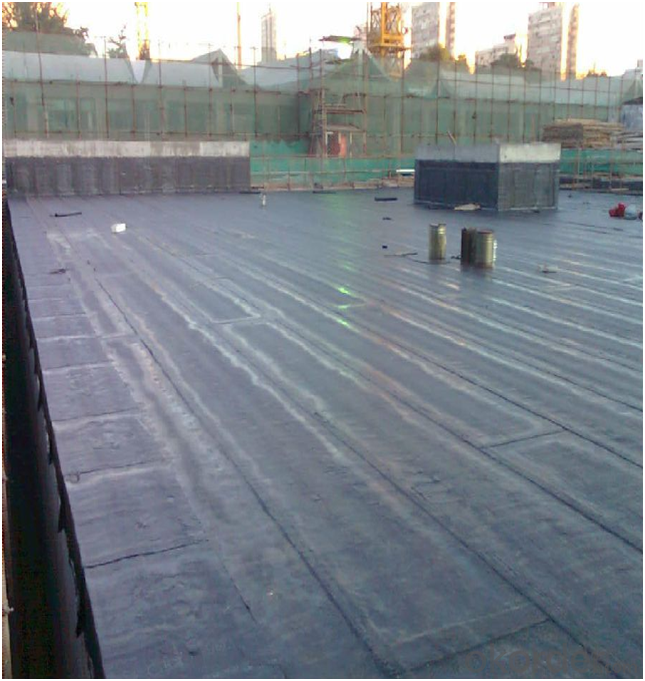


FAQ:
1. What are we supplying?
We are specialized in producing Colorful Asphalt Roof Shingle, SBS/APP modified bitumen waterproof membrane, Self adhesive bitumen waterproof membrane, PVC waterproofing membrane, EPDM rubber roofing membrane, Single Component Polyurethane Waterproof Coating, and Spray Polyurea Waterproof Coating.
2. How Many years experience do we have?
We have been exported to more than 20 countries in the past 15 years.
3. How long do we usually reply your request?
We always reply our customer within 24 hours.
- Q: Is a waterproofing membrane resistant to root penetration?
- A waterproofing membrane is usually able to resist root penetration. Its purpose is to create a barrier that prevents water from seeping through and causing damage to the underlying structures. These membranes are typically made from durable materials like modified bitumen, PVC, or EPDM, which are highly resistant to root penetration. Some membranes are even specially manufactured with properties that deter root growth, providing an extra layer of protection against potential root damage. Root-resistant waterproofing membranes may contain additives that discourage root growth, or they may have a thicker and stronger composition that can withstand root penetration. However, it is important to note that while waterproofing membranes are generally effective in preventing root penetration, proper installation and regular inspection are necessary to ensure their long-term integrity.
- Q: Can a waterproofing membrane be used in areas with high levels of salt or saltwater exposure?
- Yes, a waterproofing membrane can be used in areas with high levels of salt or saltwater exposure. Waterproofing membranes are designed to provide a protective barrier against moisture, including saltwater. They are often used in coastal regions, marine environments, or areas with high salt content in the soil to prevent water damage and corrosion.
- Q: Can a waterproofing membrane be used in renovation or retrofitting projects?
- Yes, a waterproofing membrane can definitely be used in renovation or retrofitting projects. In fact, it is often a critical component in such projects to ensure the long-term durability and protection of the building or structure. Waterproofing membranes are designed to create a barrier against moisture infiltration, preventing water damage, mold growth, and structural deterioration. During renovation or retrofitting, it is common to encounter issues like leaks, cracks, or deteriorated building materials that compromise the building's waterproofing system. In such cases, applying a waterproofing membrane over the affected areas can effectively seal and protect them from further damage. This can be done both on the interior and exterior of the building, depending on the specific requirements. Waterproofing membranes come in various forms, such as sheet membranes, liquid coatings, or spray-applied membranes. They can be applied to different surfaces like roofs, walls, basements, or even foundations. These membranes are flexible, durable, and resistant to water and other environmental stresses, making them ideal for renovation or retrofitting projects where there is a need to enhance the building's waterproofing capabilities. In conclusion, incorporating a waterproofing membrane in renovation or retrofitting projects is highly recommended to ensure the longevity and integrity of the building. It serves as a proactive measure to prevent future water damage, maintain structural stability, and improve the overall quality of the renovated or retrofitted space.
- Q: How to distinguish the degree of sbs waterproofing membrane?
- How much of the weight of the waterproofing membrane is the "low temperature flexibility" of the web is the bending performance of the web in a negative temperature condition, and it is said that it is bent in a very cold environment without cracking. Generally speaking, the low temperature of the synthetic polymer membrane is better, and the low temperature performance of the modified asphalt membrane is related to the modification technology.
- Q: Can waterproofing membranes be used on outdoor decks?
- Outdoor decks can indeed benefit from the use of waterproofing membranes. These membranes are highly favored among deck owners due to their ability to effectively block moisture, thus safeguarding the underlying structure from harm. Comprised of durable materials like rubber or PVC, these membranes are specifically crafted to endure exposure to the elements. They are directly applied onto the deck surface, effectively establishing a watertight seal that serves as a protective shield against rain, snow, and other forms of moisture. Moreover, by preventing water damage, rot, and decay, waterproofing membranes contribute significantly to extending the lifespan of the deck. Consequently, incorporating waterproofing membranes into the maintenance routine of outdoor decks proves to be not only a sensible approach but also an efficient one, ensuring the deck's structural integrity and longevity are well-preserved.
- Q: Can a waterproofing membrane be used on precast stone block surfaces?
- Yes, a waterproofing membrane can be used on precast stone block surfaces. Waterproofing membranes are commonly used to prevent water penetration and moisture damage in various types of surfaces, including precast stone blocks. These membranes are designed to create a barrier against water, preventing it from seeping into the surface and causing issues such as mold, deterioration, or structural damage. Applying a waterproofing membrane to precast stone block surfaces can help enhance their durability and longevity by protecting them from water-related problems. However, it is important to carefully follow the manufacturer's instructions and ensure that the chosen waterproofing membrane is suitable for the specific type of precast stone block surface being treated.
- Q: Can a waterproofing membrane be used on zinc surfaces?
- Certainly! Zinc surfaces can indeed benefit from the application of a waterproofing membrane. Zinc is widely used for its durability and resistance to corrosion, making it a popular choice for various purposes such as roofing and cladding. By adding a waterproofing membrane to zinc surfaces, an extra layer of protection against water intrusion and moisture damage can be achieved. This not only helps prevent leaks, but also extends the lifespan of the zinc surface and preserves its overall integrity. However, it is crucial to ensure that the chosen waterproofing membrane is compatible with zinc and specifically designed for such applications. To determine the most suitable waterproofing solution for zinc surfaces, it is advisable to seek professional advice or consult with the manufacturer.
- Q: What is the resistance type SBS waterproofing membrane?
- The second is chemical resistance, in the waterproofing membrane production process, adding chemical resistance agent, similar to the chemical composition of herbicides, the plant roots are not close to the waterproofing membrane; In addition, copper ions have a similar effect.
- Q: Can a waterproofing membrane be used for water tanks?
- Yes, a waterproofing membrane can be used for water tanks. Waterproofing membranes are specifically designed to prevent water leakage and can be applied to various surfaces, including water tanks, to create a watertight seal and protect against water damage.
- Q: Can a waterproofing membrane be installed on wood surfaces?
- Yes, a waterproofing membrane can be installed on wood surfaces.
Send your message to us
EPDM Waterproofing Roofing Membrane with 1.2mm 1.5mm 2.0mm
- Loading Port:
- Qingdao
- Payment Terms:
- TT OR LC
- Min Order Qty:
- 2000 m²
- Supply Capability:
- 800000 m²/month
OKorder Service Pledge
OKorder Financial Service
Similar products
Hot products
Hot Searches
Related keywords

